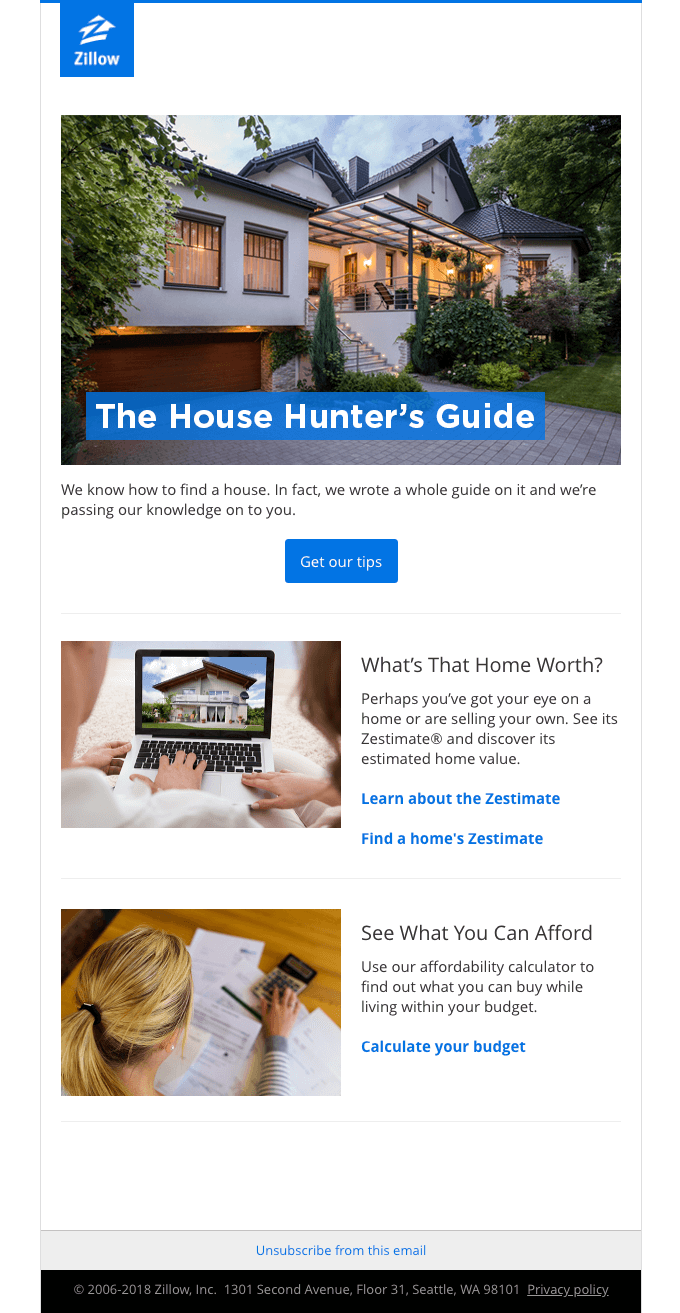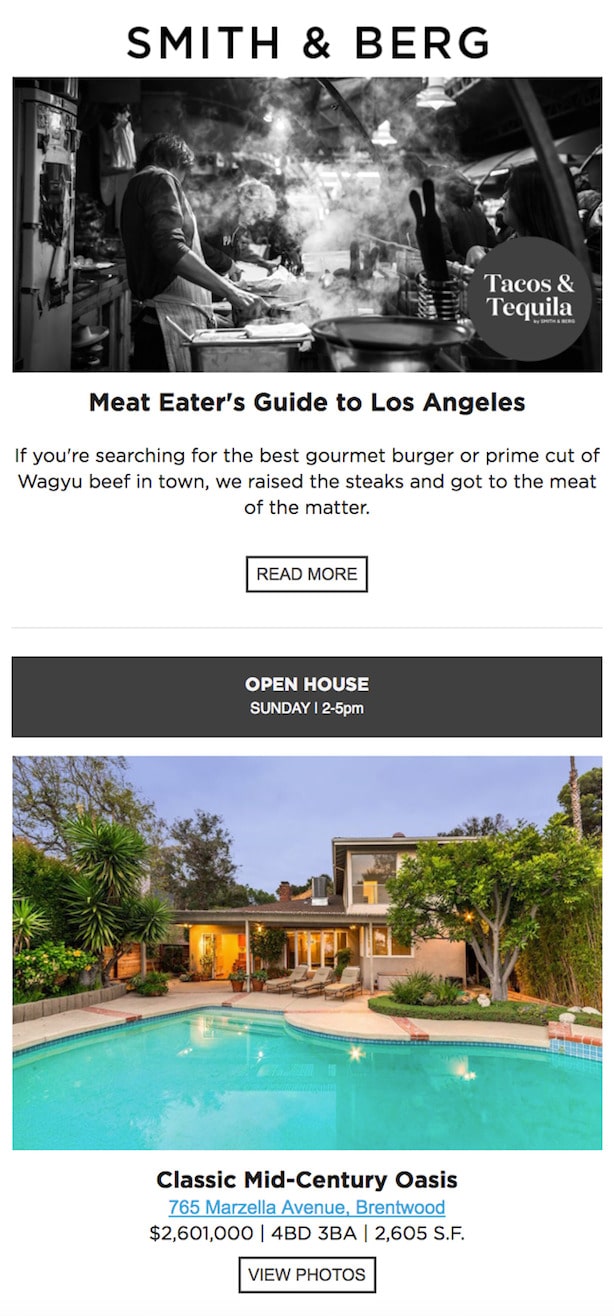7 Real estate email marketing strategies to try
Does your company have a successful real estate email marketing strategy in place?
If not, developing one should be the next priority on your to-do list.
Successful email campaigns regularly prove to offer the most ROI of any channel, which is an especially compelling claim for real estate agencies, as lead generation in this industry tends to be very expensive.
Nonetheless, that high ROI is only claimed by agencies that understand what it takes to design successful campaigns.
7 strategic tips for real estate email marketing
A successful email campaign is the sum of many parts that work together.
This includes building your actual list and choosing the right real estate email marketing solution.
It will probably also entail a little trial-and-error, too.
Over time, you’ll realize what works and what doesn’t, eventually arriving at a plan you can continue to scale and replicate.
Fortunately, we can save you some time here. Below are seven real estate email marketing strategies that really work, even though most agencies don’t know about them.
1. Send out regular FAQ emails.
Not everyone who signs up for your emails will be ready to buy a home right away. Many of them may even be a year or more away from finally beginning their formal search for the perfect home, so it's important to send content that's relevant to buyers on all
This is still a very important segment to focus on, though. Eventually, they will be ready to buy. When they do, you want them to contact your agency for help making the right decision.
One simple way to keep them engaged during this time is with a regular “Ask a realtor” email. Articles about what realtors wish you knew have always been popular because people want to make sure they know everything they need to before making such a big purchase.
With a newsletter, you can meet this demand and maintain engagement with a regular email that gives recipients this very information.
Better still, create a video where one of your realtors actually discusses the topic from your office. Aside from giving your recipients the information they want, the other benefit of this idea is that it will help prospects familiarize themselves with your staff, a big advantage when they’re ready to hire an agent.
2. Drive traffic to a landing page.
One of the biggest real estate email marketing mistakes you can make is to drive traffic to your agency’s homepage or “Contact Us” page.
This may work for companies in other industries, but real estate is different. At best, this traditional approach will fall far short of your strategy’s full potential.
Instead, send traffic to individual landing pages you’ve created for specific home listings. Then, use Google Analytics to track their success with visitors.
Take a look at how Zillow does this:
Image: Really Good Emails
By offering numerous CTAs, Zillow can track their traffic to see which kind of content different leads care about most, making it easier to continue bringing them through their conversion funnel.
While you can definitely post these pages to your social media accounts, too, you’ll want to use UTM tags if you do.
In fact, use these tags for any links you share through your emails as they will make it easy to distinguish the source of your traffic and, thus, measure the success of your real estate email marketing strategy.
3. Give plenty of attention to neighborhoods, too.
Your real estate email marketing strategy shouldn’t just focus on individual homes. Instead, make regular space for emails that will introduce potential buyers to neighborhoods, too.
After all, every house hunter knows that rule number one is, “location, location, location.”
This is why another very popular form of real-estate-related content is articles about what to look for in neighborhoods. Your emails can cover similar topics about neighborhoods where you’re selling homes. These would include:
- Average Home Prices
- Average Household Incomes
- Information About Local Schools
- Ratio of Owner-Occupied Homes to Rentals
- Safety
Basically, any aspect that will help prospects fall in love with a given area.
Here’s a really fun twist on the idea from Smith & Berg:
Image: Mail Bakery
Don’t forget about things like community events, local restaurants, parks, and other aspects that make a neighborhood feel like home. You should include pictures, as well.
Make it as easy as possible for your email recipients to fall in love with the neighborhoods you’re highlighting, and you can expect to receive a lot of emails inquiring about homes in the area.
4. Create ongoing content for homeowners.
Once a prospect turns into an actual client and then a homeowner, you may think that’s the end of your real estate email marketing campaign. It effectively sold a home, so it’s been a complete success, right?
Not exactly.
If your realtors are like most, almost half of their business comes from referrals.
This is why it’s so important for them to continuously stay in touch with past clients. House hunters always ask their homeowner friends for advice and one of the most common questions is, “Did you like your realtor?”
Obviously, there’s no substitution for simply creating great relationships.
However, your real estate email marketing strategy can help with this and keep your agency in front of former clients, even years after they’ve bought their home.
You can achieve this by regularly sending out emails that aren’t about buying homes but about maintaining and improving them. People are always on the lookout for tips on taking care of such an important investment. By offering this advice for free, you give homeowners a good reason to keep an eye out for your emails. As a result, you’ll also come to mind when a house-hunting friend asks them that all-important question.
Look at the example from realtor Corinne Bernard, who continues emailing her list with fun topics long after the sale:
5. Show off your nicest homes.
As any good realtor knows, budget is one of the most important concerns when trying to find a client’s perfect home. They might show them a few homes at the high-end of their budgets – maybe even slightly over – but no client wants to keep seeing homes they know they can’t afford.
Or do they?
House Hunters is one of the most popular shows on television, regularly airing roughly 450 episodes a year just to keep up with demand.
One reason for the popularity of this show–and the proliferation of countless similar versions—is because so many people love imagining themselves in a position to afford any home they want.
Fantasizing via online real estate has become an extremely popular pastime.
You can use this to your real estate email marketing strategy’s advantage by regularly showing your list examples of high-end homes your realtors are currently trying to sell.
The key is to make this a regular feature, one that's all about letting customers peek inside gorgeous homes with no strings attached.
Of course, some of your recipients may actually be quite interested in buying it (positioning the home as high-end and enviable won’t hurt), but you want to make sure the rest of your list knows that’s why they’re seeing it and not because it’s a serious recommendation.
6. Make the most of social proof.
Having an agency blog isn’t a bad idea. You can even use your real estate email marketing list to drive traffic to your posts, provided you use UTM tags as we described earlier.
One of the many reasons a blog is a good investment is because comments and shares give your agency social proof. In effect, it shows readers, “lots of people really like this agency.” In turn, they’re more apt to like your agency, as well, and see it as a reliable resource – both for information about real estate and for actual realtors.
Even the most successful real estate email marketing campaigns don’t offer much in the way of social proof. It’s not as though your recipients can see just how many other people are on the list with them.
That’s why you’ll have to make a point of doing so.
Fortunately, you have a couple of options to choose from.
The first is to highlight a recent client through a case study. Walk your readers through the journey they went on to find and finally buy their dream house. Aside from the fact that this can be helpful information, it also shows your list how helpful you are. Do this enough times and it will also become clear that a lot of people trust your agency.
Another option is to actively invite people to “Ask a realtor” and then include their names in that email. Once again, you’re providing helpful information and displaying social proof.
You can also sprinkle social proof through your regular messages.
Mention how long you’ve been in business for (the longer, the more people you’ve clearly helped), how many homes you’ve sold (“After selling more than 10,000 homes, our agency understands…”), and any recognition you’ve received or awards you’ve won.
7. Keep an eye on the competition.
If your competitors are also investing in real estate email marketing, it would be wise to keep an eye on their efforts.
All you have to do is sign up for their email list and check their messages regularly.
As much as we’d like to think we covered the most underrated, yet effective, real estate email marketing strategies in this post, it’s possible your competition may have stumbled on a couple too. Even something as simple as how often they send out emails can play an important role in improving your campaigns.
Wrap up
Real estate email marketing has the potential to create a reliably consistent source of new leads for your agency.
However, in order to realize that potential, you need to go above and beyond what most agencies do.
Follow the advice above and you’ll soon have an email marketing strategy that regularly brings your agency new clients.
MOST RECENT ARTICLES
Want to engage your audience and grow your brand? Try Emma's robust easy-to-use product today.















